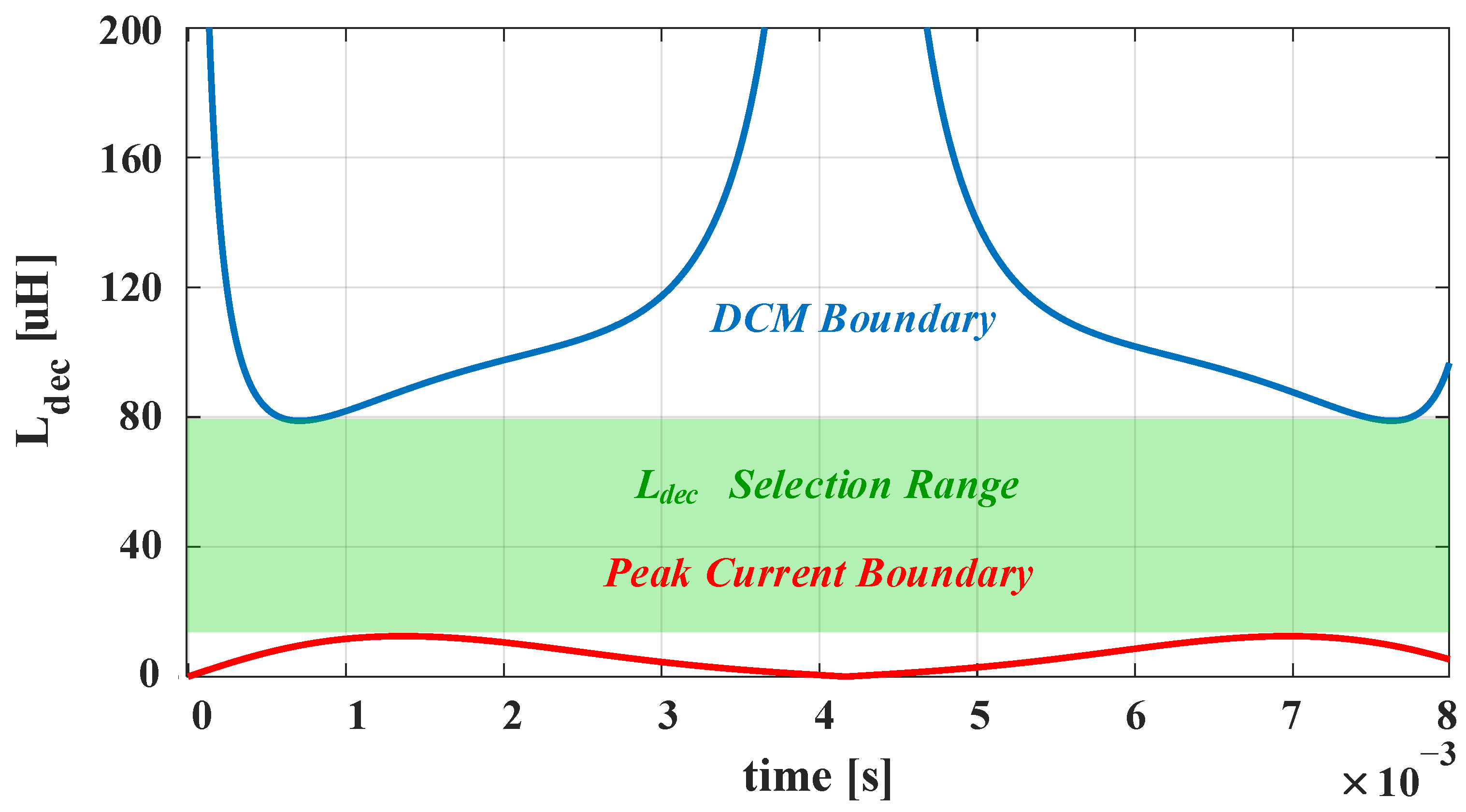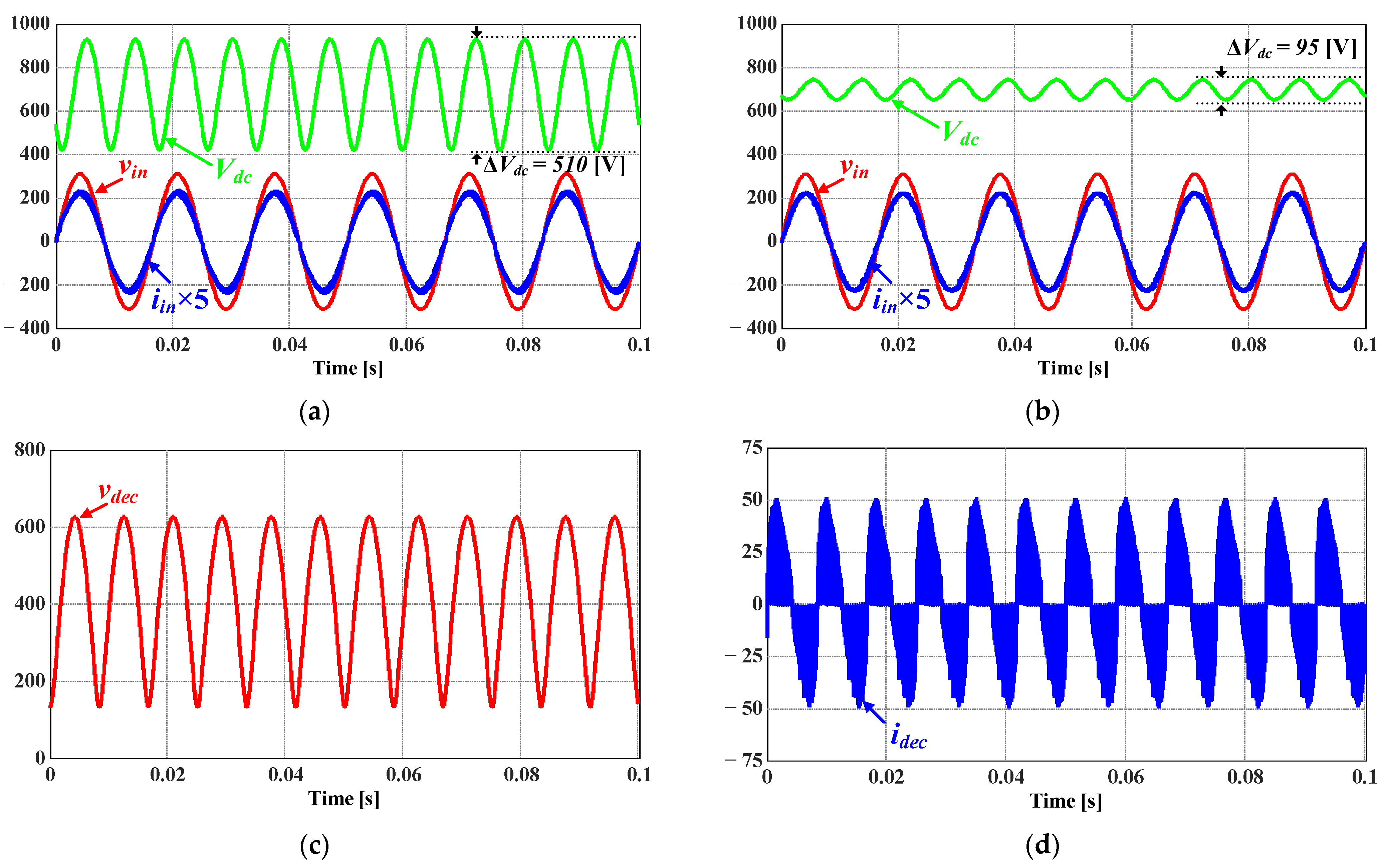Design and Analysis of High Power Density On-Board Charger with Active Power Decoupling Circuit for Electric Vehicles
Abstract
:1. Introduction
2. Design of APD Circuit for High Power Density
2.1. Conventional APD Circuit Design

2.2. Proposed APD Circuit Design
3. Verification
4. Conclusions
Author Contributions
Funding
Data Availability Statement
Conflicts of Interest
References
- Iodice, P.; Fornaro, E.; Cardone, M. Hybrid Propulsion in SI Engines for New Generation Motorcycles: A Numeri-cal-Experimental Approach to Assess Power Requirements and Emission Performance. Energies 2022, 15, 6312. [Google Scholar] [CrossRef]
- Yilmaz, M.; Krein, P.T. Review of battery charger topologies, charging power levels, and infrastructure for plug-in electric and hybrid vehicles. IEEE Trans. Power Electron. 2012, 28, 2151–2169. [Google Scholar] [CrossRef]
- Khaligh, A.; D’Antonio, M. Global trends in high-power on-board chargers for electric vehicles. IEEE Trans. Veh. Technol. 2019, 68, 3306–3324. [Google Scholar] [CrossRef]
- Whitaker, B.; Barkley, A.; Cole, Z.; Passmore, B.; Martin, D.; McNutt, T.R.; Lostetter, A.B.; Lee, J.S.; Shiozaki, K. A High-Density, High-Efficiency, Isolated On-Board Vehicle Battery Charger Utilizing Silicon Carbide Power Devices. IEEE Trans. Power Electron. 2014, 29, 2606–2617. [Google Scholar] [CrossRef]
- Li, B.; Li, Q.; Lee, F.C.; Liu, Z.; Yang, Y. A High-Efficiency High-Density Wide-Bandgap Device-Based Bidirectional On-Board Charger. IEEE J. Emerg. Sel. Topics Power Electron. 2018, 6, 1627–1636. [Google Scholar] [CrossRef]
- Zhou, K.; Chen, S.-M.; Jin, N.-Z.; Sun, D.Y. Research on Single-Phase and Three-Phase Compatible Isolated On-Board Charger and Control Technology. Energies 2022, 15, 6445. [Google Scholar] [CrossRef]
- Zhao, W.H.; Shen, Y.X. Review on the research of electric vehicle on-board charger topologies. Control Eng. China 2019, 26, 29–36. [Google Scholar]
- Dai, H.C.; Ye, X.T.; Shou, Y.L.; Wang, Z.S. Research on control strategy of on-board charger (OBC) based on PFC and LLC two-level structure. Electr. Eng. 2020, 11, 38–42. [Google Scholar]
- Hu, H.; Harb, S.; Kutkut, N.; Batarseh, I.; Shen, Z.J. A Review of Power Decoupling Techniques for Microinverters With Three Different Decoupling Capacitor Locations in PV Systems. IEEE Trans. Power Electron. 2013, 28, 2711–2726. [Google Scholar] [CrossRef]
- Gautam, A.R.; Fulwani, D.M.; Makineni, R.R.; Rathore, A.K.; Singh, D. Control Strategies and Power Decoupling Topologies to Mitigate 2w-Ripple in Single-Phase Inverters: A Review and Open Challenges. IEEE Access 2020, 8, 147533–147559. [Google Scholar] [CrossRef]
- Sun, Y.; Liu, Y.; Su, M.; Xiong, W.; Yang, J. Review of Active Power Decoupling Topologies in Single-Phase Systems. IEEE Trans. Power Electron. 2016, 31, 4778–4794. [Google Scholar] [CrossRef]
- Yamaguchi, S.; Shimizu, T. A Single-Phase Power Conditioner with a Buck-Boost-Type Power Decoupling Circuit. In Proceedings of the 2014 International Power Electronics Conference (IPEC-Hiroshima 2014—ECCE ASIA), Hiroshima, Japan, 18–21 May 2014; pp. 3771–3777. [Google Scholar]
- Tang, Y.; Blaabjerg, F.; Loh, P.C.; Jin, C.; Wang, P. Decoupling of Fluctuating Power in Single-Phase Systems Through a Symmetrical Half-Bridge Circuit. IEEE Trans. Power Electron. 2015, 30, 1855–1865. [Google Scholar] [CrossRef]
- Tang, Y.; Qin, Z.; Blaabjerg, F.; Loh, P.C. A Dual Voltage Control Strategy for Single-Phase PWM Converters With Power Decoupling Function. IEEE Trans. Power Electron. 2015, 30, 7060–7071. [Google Scholar] [CrossRef]
- Larsson, T.; Ostlund, S. Active DC link Filter for Two Frequency Electric Locomotives. In Proceedings of the 1995 International Conference on Electric Railways in a United Europe, Amsterdam, The Netherlands, 27–30 March 1995; pp. 97–100. [Google Scholar]
- Han, H.; Liu, Y.; Sun, Y.; Su, M.; Xiong, W. Single-phase Current Source Converter with Power Decoupling Capability using a Series-Connected Active Buffer. IET Power Electron. 2015, 8, 700–707. [Google Scholar] [CrossRef]
- Shimizu, T.; Jin, Y.; Kimura, G. DC ripple current reduction on a single-phase PWM voltage-source rectifier. IEEE Trans. Ind. Appl. 2000, 36, 1419–1429. [Google Scholar] [CrossRef]
- Vitorino, M.A.; Correa, M.B.D.R. Compensation of DC link oscillation in single-phase VSI and CSI converters for photovoltaic grid connection. IEEE Trans. Ind. Appl. 2014, 50, 2021–2028. [Google Scholar] [CrossRef]
- Wang, R.; Wang, F.; Boroyevich, D.; Burgos, R.; Lai, R.; Ning, P.; Rajashekara, K. A High Power Density Sing-Phase PWM Rectifier With Active Ripple Energy Storage. IEEE Trans. Power Electron. 2011, 26, 1430–1443. [Google Scholar] [CrossRef]
- Nguyen, H.V.; Lee, D. Reducing the dc-Link Capacitance: Bridgeless PFC Boost Rectifier That Reduces the Second-Order Power Ripple at the dc Output. IEEE Ind. Appl. Mag. 2019, 24, 23–34. [Google Scholar] [CrossRef]
- Prasad, R.; Namuduri, C.; Kollmeyer, P. Onboard unidirectional automotive G2V battery charger using sine charging and its effect on li-ion batteries. In Proceedings of the 2015 IEEE Energy Conversion Congress and Exposition (ECCE), Montreal, CA, USA, 20–24 September 2015; pp. 6299–6305. [Google Scholar]
- Bessman, A.; Soares, R.; Vadivelu, S.; Wallmark, O.; Svens, P.; Ekstrom, H.; Lindbergh, G. Challenging Sinusoidal Ripple-Current Charging of Lithium-ion Batteries. IEEE Trans. Ind. Electron. 2018, 65, 4750–4757. [Google Scholar] [CrossRef]
- Nassary, M.; Orabi, M.; Ghoneima, M.; Aroudi, A.E.; El-Nemr, M.K. A High Current Ripple EV Battery Charger Utilizing Capacitor-less CUK Converter. In Proceedings of the 2019 IEEE Conference on Power Electronics and Renewable Energy (CPERE), Aswan, Egypt, 23–25 October 2019; pp. 232–237. [Google Scholar]












| Parameters | Value |
|---|---|
| Input voltage, vin | 220 Vrms |
| DC-link voltage, Vdc | 700 V |
| PFC Converter rated power, P | 6.6 kW |
| PFC converter switching frequency, fsw,PFC | 50 kHz |
| APD circuit switching frequency, fsw,APD | 50 kHz |
| Item | Design Result |
|---|---|
| Decoupling inductor, Ldec | Changsung/CH330060 × 2/40 [μH] |
| Decoupling capacitor, Cdec | WIMA/DCP4L054007I × 4/160 [μF] |
| Power Decoupling Type | Item | Value | Volume |
|---|---|---|---|
| Passive power decoupling | Cdc | 720 [μF] | 259.2 [mL] |
| Active power decoupling | Cdc | 40 [μF] | 59.2 [mL] |
| Cdec | 160 [μF] | 236.8 [mL] | |
| Ldec | 40 [μH] | 26.6 [mL] | |
| SWdec | - | 3.9 [mL] |
| Power Decoupling Type | Item | Value | Volume |
|---|---|---|---|
| Passive power decoupling (Electrolytic capacitor) | Cdc | 720 [μF] | 259.2 [mL] |
| Passive power decoupling (Film capacitor) | Cdc | 270 [μF] | 500.2 [mL] |
| Conventional active power decoupling | Cdc | 40 [μF] | 59.2 [mL] |
| Cdec | 160 [μF] | 236.8 [mL] | |
| Ldec | 40 [μH] | 26.6 [mL] | |
| SWdec | - | 3.9 [mL] | |
| Proposed active power decoupling | Cdc | 40 [μF] | 59.2 [mL] |
| Cdec | 80 [μF] | 118.4 [mL] | |
| Ldec | 40 [μH] | 26.6 [mL] | |
| SWdec | - | 3.9 [mL] |
| Item | Value | [Unit] |
|---|---|---|
| Input voltage, vin | 220 | [Vrms] |
| PFC converter output power, Po | 6.6 | [kW] |
| APD circuit power, Pdec | 5.66 | [kW] |
| DC-link voltage, Vdc | 700 | [V] |
| Maximum APD voltage, vdec,max | 650 | [V] |
| PFC converter switching frequency, fsw,PFC | 50 | [kHz] |
| APD circuit switching frequency, fsw,APD | 50- | [kHz] |
| Item | Mark | Vendor/Model/Value |
|---|---|---|
| PFC switch | S1, S2, S3, S4 | Wolfspeed/C3M0075120D/- |
| PFC diode | D1, D2 | ST/STP3C40H12C/- |
| Input inductor | Lin,A, Lin,B | Changsung/CH330060 × 3/350 [μH] |
| DC-link capacitor | Cdc | WIMA/DCP4L054007ID4MSSD/40 [μF] |
| APD switch | S5, S6 | Wolfspeed/C3M0032120D/- |
| Decoupling inductor | Ldec | Changsung/CH330060 × 2/40 [μH] |
| Decoupling capacitor | Cdec | WIMA/DCP4L054007I × 2/80 [μF] |
Disclaimer/Publisher’s Note: The statements, opinions and data contained in all publications are solely those of the individual author(s) and contributor(s) and not of MDPI and/or the editor(s). MDPI and/or the editor(s) disclaim responsibility for any injury to people or property resulting from any ideas, methods, instructions or products referred to in the content. |
© 2023 by the authors. Licensee MDPI, Basel, Switzerland. This article is an open access article distributed under the terms and conditions of the Creative Commons Attribution (CC BY) license (https://creativecommons.org/licenses/by/4.0/).
Share and Cite
Son, W.-J.; Lee, B.K. Design and Analysis of High Power Density On-Board Charger with Active Power Decoupling Circuit for Electric Vehicles. Energies 2023, 16, 7450. https://doi.org/10.3390/en16217450
Son W-J, Lee BK. Design and Analysis of High Power Density On-Board Charger with Active Power Decoupling Circuit for Electric Vehicles. Energies. 2023; 16(21):7450. https://doi.org/10.3390/en16217450
Chicago/Turabian StyleSon, Won-Jin, and Byoung Kuk Lee. 2023. "Design and Analysis of High Power Density On-Board Charger with Active Power Decoupling Circuit for Electric Vehicles" Energies 16, no. 21: 7450. https://doi.org/10.3390/en16217450
APA StyleSon, W.-J., & Lee, B. K. (2023). Design and Analysis of High Power Density On-Board Charger with Active Power Decoupling Circuit for Electric Vehicles. Energies, 16(21), 7450. https://doi.org/10.3390/en16217450







